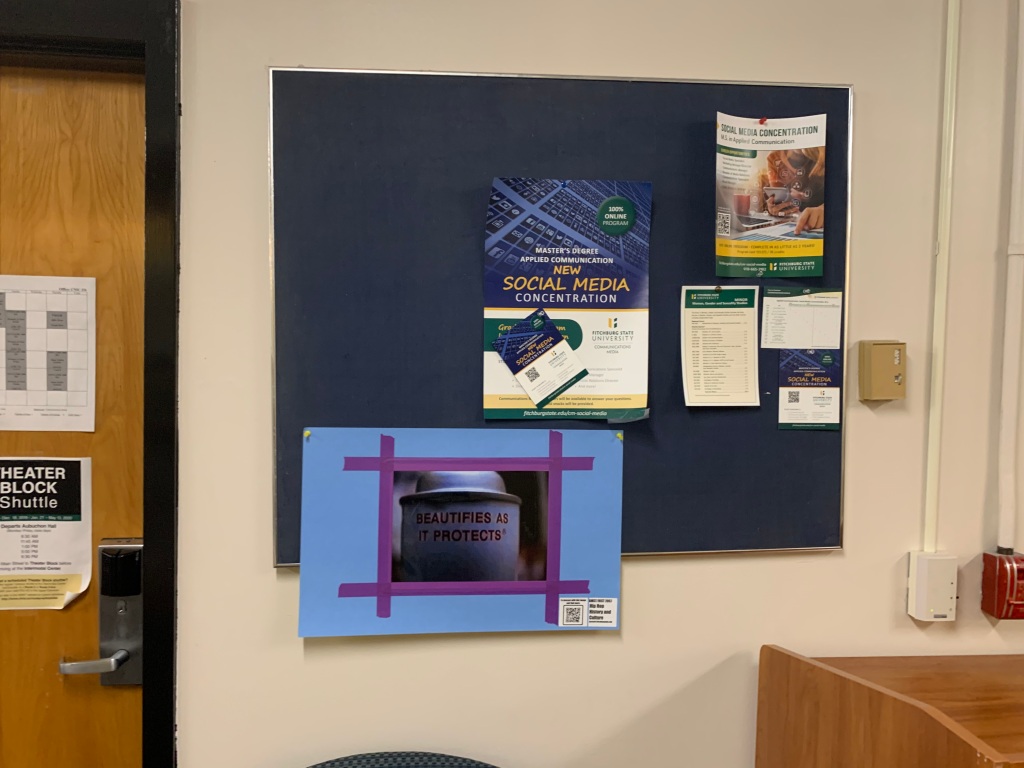In Fall 2020, students used the following prompt to create our virtual and IRL exhibit on the campus of Fitchburg State University.
Navigate this Page:

Assignment Instructions
Visual Collaboration – Bronx 1983
Professor Bob Harris in Communications Media was curator of Video Art at two prominent institutions and freelance curating with others in the late 70’s-mid 80’s. Two sociology professors contacted him for assistance with a National Science Foundation grant to research graffiti culture in New York City. Harris explains, “They had done some preliminary interviews with a few prominent artists, but the material was dry and poorly produced. They hoped I would connect them with someone. We did the work “commissioned” by them, but kept the rights to show it ourselves. Rii Kanazaki was a painter turned video maker and very interested in the electronic manipulation of the video signal… The material on YouTube is there because artists would give materials to ETVC for their archive. Artists working at the facility could pick through the library and watch things.”
We are in a strange permissions paradox not too far distant from the sampling issues in hip hop. Despite the fact that artists should have clearance on their work being posted, it nonetheless is available in these two compilations of raw footage:
(Note: these links have since been taken down because they were posted without the creators’ permission. We are in the process of working with the filmmakers to archive the raw footage and documentaries for research purposes.)
Rii Kanzaki & Bob Harris: Rocking ’83 – Graffitti https://www.youtube.com/watch?v=1R1R8Mi0Dzs&t=369s
Rii Kanzaki & Bob Harris: Rocking ’83 – Bear’s Jam https://www.youtube.com/watch?v=W7fjTx-TfH8&t=3108s
Your task: reflect on what you have learned about the origins and elements of hip hop culture, its historical context, and the significance of the Bronx in this story. Select a still image from the footage, using a screenshot, describe and interpret what you see.
Alternatively: if you decide you would like to protect your work under fair use more extensively, create your own image or representation of an aspect of hip hop’s context and development. This is a decision you will have to make after considering the law, context, and content.
Then EXPLAIN in an artist’s statement:What context helps you interpret the image? What experiences, controversies, and historical interpretations about hip hop’s origins and significance are or are not portrayed in the still? Cite at least TWO-THREE sources from class (lecture, readings, primary sources) to contextualize your image and interpretation. Your interpretation should be approx. 3 paragraphs, or 750-1100 words. Provide at least four metadata tags for your interpretation to help us catalog and organize the entries
The Virtual Exhibit
Ethical Questions
Students had to confront whether these screenshots constituted fair use of another artist’s work. We watched Copyright Criminals in class, read Nelson George’s “Sample This” essay from Forman/Neal eds. That’s the Joint! reader, and considered the various questions and debates surrounding sampling and fair use in hip hop and beyond. They filled out a worksheet to determine if they would take the risk of using the image, or if they would manipulate it or create their own representation to protect themselves. In class, we will talk with Prof. Robert Harris, one of the filmmakers who produced the footage, to get his take on questions of fair use, art, and artist remuneration issues, particularly in the digital era.
The Physical Exhibit (some have gone wandering since)


























